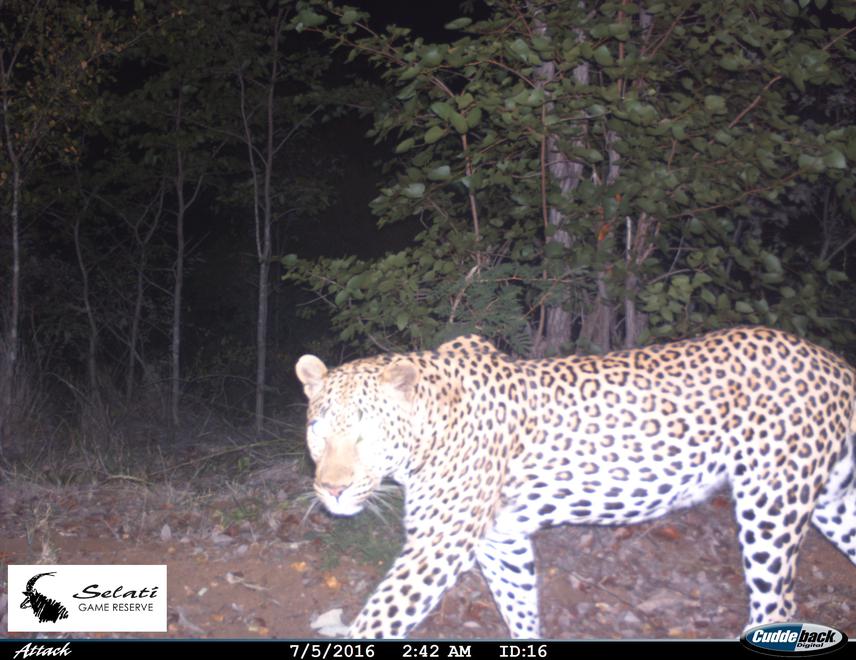Jessica Comley
Other projects
16 Sep 2019
Population Genetics of Brown Hyaena (Parahyaena brunnea) in the Eastern Cape, South Africa
Our research aims to gain a better understanding of how multiple carnivore species interact and utilize available resources within a small, enclosed reserve (Selati Game Reserve, Limpopo) through the use of camera trap surveys, movement analyses (data collected from collared large carnivores)and diet analyses.

Terrestrial ecosystems generally contain multiple carnivore species which not only compete for shared resources but also pose a threat to one another (1). Carnivore intra-guild competition can be particularly intense as carnivores are both morphologically and behaviourally adapted for killing (2). Although the only intact guild of large carnivores can be found in Africa, our understanding of the extent of intra-guild competition is heavily biased towards canids in the northern hemisphere where the main focus has been on the role of direct killing (3,4,5). Additionally, the majority of studies on carnivore intra-guild competition have looked at the interactions between pairs of carnivore species, completely overlooking the interactions occurring among subordinate carnivores (6). Thus, there are many looming uncertainties about how exactly intra-guild competition negatively effects carnivore populations (5,7). A better understanding of the complex interactions of multiple-carnivore communities is therefore needed (4,7).
Throughout most of Africa, large carnivores are restricted to reserves or conservational areas because of human-wildlife conflict which arises due to the perceived or actual threat that free ranging carnivores pose to livestock and/or human life (8). In South Africa, however, there are very few free-ranging large carnivores, as most reserves are completely bound by electrified, predator-proof fencing (9). Often these reserves are small (<400km (2)) and are unable to naturally support viable populations of large carnivores (10). In addition, the likelihood of competition or killing among carnivore guild members within these small, enclosed reserves may increase, as artificially high population densities are created due to the clumping of competing carnivores (11). Unfortunately, the ways in which multiple carnivore species utilize and partition space and resources in small, enclosed reserves of South Africa is currently poorly understood (1). Understanding how animals utilize available resources is important for their conservation, as it provides insight into the ecological needs of the species (10).
In order for small, enclosed reserves to play a significant role in the conservation of carnivores, site-specific management decisions need to be made with regards to the area, density of prey and predators as well as to take into account the complex interactions among carnivores (4,10). Given Africa’s rapidly expanding human population, enclosed reserves may become increasingly important for carnivore conservation (10). Therefore, understanding the fundamental roles and population potentials of carnivores within a small, enclosed system such as, Selati Game Reserve is vital.
1/ Vanak AT, Fortin D, Thaker M, Ogden M, Owen C, Greatwood S, Slotow R. 2013. Moving to stay in place: Behavioral mechanisms for coexistence of African large carnivores. Ecology 94: 2619–2631.
2/ Palomares F, Caro TM. 1999. Interspecific Killing among Mammalian Carnivores. The American Naturalist 153: 492–508.
/3 Dalerum F, Cameron EZ, Kunkel K, Somers MJ. 2009. Diversity and depletions in continental carnivore guilds: implications for prioritizing global carnivore conservation. Biology Letters 5: 35–38.
4/ Ritchie EG, Johnson CN. 2009. Predator interactions, mesopredator release and biodiversity conservation. Ecology Letters 12: 982–998.
5/ Watts HE, Holekamp KE. 2008. Interspecific competition influences reproduction in spotted hyenas. Journal of Zoology 276: 402–410.
6/ Owen-Smith N, Mills MGL. 2008. Predator-prey size relationships in an African large-mammal food web. Journal of Animal Ecology 77: 173–183.
7/ Ripple WJ, Estes J a, Beschta RL, Wilmers CC, Ritchie EG, Hebblewhite M, Berger J, Elmhagen B, Letnic M, Nelson MP, Schmitz OJ, Smith DW, Wallach AD, Wirsing AJ. 2014. Status and ecological effects of the world’s largest carnivores. Science 343: 1241484–1 – 124148–11.
8/ Rust NA, Marker LL. 2013. Attitudes Toward Predators and Conservancies Among Namibian Farmers. Human Dimensions of Wildlife 18: 463–468.
9/ Cozzi G, Broekhuis F, McNutt JW, Turnbull LA, Macdonald DW, Schmid B. 2012. Fear of the dark or dinner by moonlight ? Reduced temporal partitioning among Africa ’ s large carnivores Fear of the dark or dinner by moonlight ? Reduced temporal partitioning among Africa ’ s large carnivores. Ecology 93: 2590–2599.
10/ Rostro-Garcia S, Kamler JF, Hunter LTB. 2015. To kill, stay or flee: The effects of lions and landscape factors on habitat and kill site selection of cheetahs in South Africa. PLoS ONE 10: 1–20.
11/ Hayward MW, Kerley GIH. 2008. Prey preferences and dietary overlap amongst Africa’s large predators. South African Journal of Wildlife Research 38: 93–108.